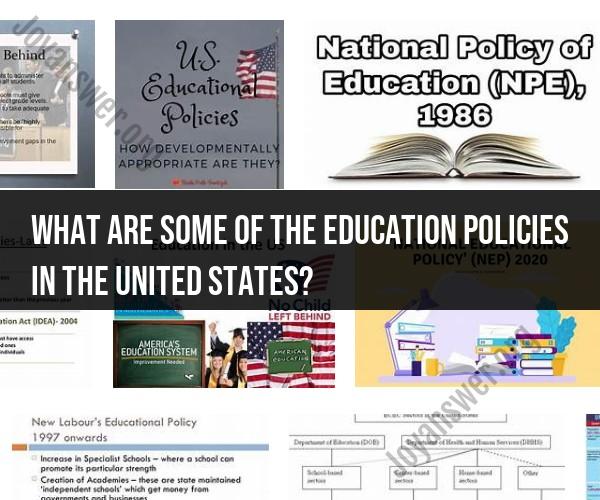What are some of the education policies in the United States?
Education policies in the United States are set at both the federal and state levels, resulting in a complex and varied landscape of educational standards and regulations. Here's an overview of some key education policies and initiatives in the United States:
No Child Left Behind (NCLB): Enacted in 2002, NCLB aimed to improve K-12 education by setting ambitious standards for student performance and holding schools accountable for meeting those standards. It required annual standardized testing in reading and math and mandated that schools make Adequate Yearly Progress (AYP) toward proficiency goals. It also introduced sanctions for schools that consistently failed to meet AYP targets.
Every Student Succeeds Act (ESSA): Passed in 2015, ESSA replaced NCLB and shifted more authority and flexibility to states in designing their own accountability systems and education plans. It maintained the requirement for annual standardized testing but allowed for a more holistic assessment of school performance, including non-academic factors.
Common Core State Standards (CCSS): Developed by the National Governors Association Center for Best Practices and the Council of Chief State School Officers, the Common Core Standards are academic benchmarks in English language arts and mathematics. While not a federal mandate, many states have adopted these standards to provide consistency in what students are expected to learn.
Special Education: Individuals with Disabilities Education Act (IDEA): IDEA ensures that students with disabilities receive a free and appropriate public education (FAPE) in the least restrictive environment. It outlines specific requirements for the identification, evaluation, and provision of services to students with disabilities.
Higher Education Act (HEA): Enacted in 1965 and reauthorized periodically, HEA governs federal financial aid programs, including Pell Grants, federal student loans, and other initiatives aimed at increasing access to higher education. It also addresses accreditation, teacher preparation programs, and other higher education policies.
School Choice: School choice policies vary widely by state but generally include charter schools, voucher programs, and open enrollment policies that allow parents to choose schools outside their residential district. Proponents argue that these options increase competition and improve educational outcomes, while critics are concerned about equity and resource distribution.
STEM Education Initiatives: In response to a perceived need for a more skilled STEM (science, technology, engineering, and mathematics) workforce, various initiatives and grants have been established to promote STEM education at all levels, from K-12 to higher education.
College and Career Readiness Initiatives: Many states have adopted college and career readiness standards that emphasize the development of skills and knowledge necessary for post-secondary education and the workforce. These standards often align with the Common Core.
Teacher Evaluation and Accountability: States have implemented various teacher evaluation systems that use student performance data as a component of teacher assessments. These systems are designed to ensure that teachers are effective in improving student learning outcomes.
English Language Learner (ELL) Programs: Given the diversity of the U.S. population, policies and programs to support English language learners are a key focus. These programs aim to help non-English-speaking students become proficient in English while meeting academic standards.
It's important to note that education policies can vary significantly from one state to another due to the decentralized nature of education governance in the United States. Additionally, education policy is a dynamic field subject to changes in federal and state legislation, court decisions, and evolving educational priorities.













